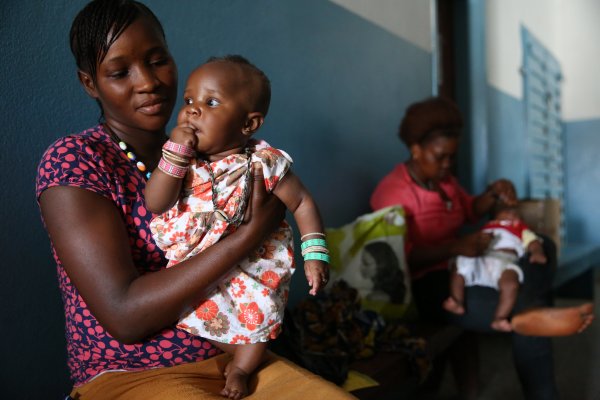Researchers call for access to Ivermectin for young children
Millions of children weighing less than 15kg are currently denied access to Ivermectin treatment due to insufficient safety data being available to support a change to the current label indication. The WorldWide Antimalarial Resistance Network (WWARN)'s new meta-analysis published today provides evidence that supports removing this barrier and improving treatment equity.

A systematic review and an individual patient data meta-analysis of Ivermectin use in children weighing less than fifteen kilograms: Is it time to reconsider the current contraindication? shows that concerns regarding the potential for neurotoxicity of Ivermectin in infancy are misplaced. The data provide limited but encouraging evidence that the Ivermectin tolerability and safety profile in children weighing less than 15kg is similar to that in heavier, older individuals.
Ivermectin is a safe, broad-spectrum anthelminthic drug registered for the treatment of several neglected tropical diseases (NTDs) including onchocerciasis, lymphatic filariasis, scabies, and strongyloidiasis. These frequently afflict young children but Ivermectin use is restricted because of a lack of evidence for the safety of these drugs – alternative treatments to ivermectin are frequently less effective or potentially even toxic.
Available data suggest that adult-based dosing is not appropriate for children and that a standard dose may not reach effective levels in small children for all NTDs. The ideal dose of Ivermectin for different indications in small children is not known and further investigation through well-designed clinical trials to optimise this and characterise the safety profile is needed. A randomised, placebo-controlled, double-blind, dose-escalation trial, called the Ivermectin Safety in Small Children trial, is underway to assess the safety, tolerability, pharmacokinetics, and scabies efficacy of escalating doses of ivermectin in children weighing less than 15 kg in Bangladesh, Brazil, Kenya and Mozambique.
WWARN's review of the literature conducted an individual-level participant data (IPD) meta-analysis across all clinical trials, case series, case reports, and database entries for reports on the use of Ivermectin in children weighing less than 15kg published between 1 January 1980 to 25 October 2019. 1,088 children weighing less than 15kg were administered oral Ivermectin and overall 1.4% experienced 18 adverse events all of which were mild and self-limiting – no serious adverse events were reported.
Dr Kevin Kobylinski from the WWARN Ivermectin Exposure in Small Children Study Group said: "Our systematic review suggests that Ivermectin is as safe and well tolerated in children weighing less than 15kg as it is in persons weighing more than 15 kg. Hopefully, this work encourages future, well-designed clinical trials and review by regulatory authorities so that the contraindication of Ivermectin use in children weighing less than 15kg can be removed allowing equitable access to ivermectin use in small children."
To continue developments in this field, greater clarity is needed when reporting Ivermectin use in children to include the weight of any child below 15kg and report any associated adverse events (AEs). An IPD call for Ivermectin safety in children weighing less than 15kg has been organised by WWARN and data from future publications, or clarifications to the publications cited, can be contributed by contacting the study authors. The evidence in this review has been compiled into an IPD database, held at WWARN, and is available on request via info@wwarn.org
The impact on populations affected by NTDs
During mass drug administration (MDA) campaigns for operational reasons and to expedite delivery, dosing is usually based on height, not weight. Only people taller than 90cm are eligible to receive Ivermectin. Many children at 90 cm weigh between 11-15kg and millions weighing less than 15kg have taken Ivermectin for onchocerciasis and lymphatic filariasis in Africa but this was not documented. Over 400 million people were treated with Ivermectin during MDAs in 2019 alone, primarily in Africa, with over four billion treatments administered via MDA to date, supporting the case that Ivermectin is a safe drug.
Ivermectin has been proposed as a novel malaria control tool due to its ability to kill Anopheles mosquitoes and Ivermectin MDAs can suppress Plasmodium transmission. Coverage is one of the most critical components of MDA efficacy and excluding children under 15kg excludes roughly 20% of the population in many malaria endemic areas. In Africa, children under five years old are frequently bitten by Anopheles and become an important reservoir of Plasmodium and facilitating its onward transmission
NTDs cause growth stunting in children, for example, infection with soil-transmitted helminths (STHs). This growth stunting means that some children may not reach 90cm until they are older but ironically are denied Ivermectin during MDA campaigns which could eliminate the very parasites causing their stunted growth. Additionally, STH infections at a young age are associated with impairment of cognitive development, and reduced school attendance further justifying the importance of including children under 15 kg in Ivermectin MDAs.
